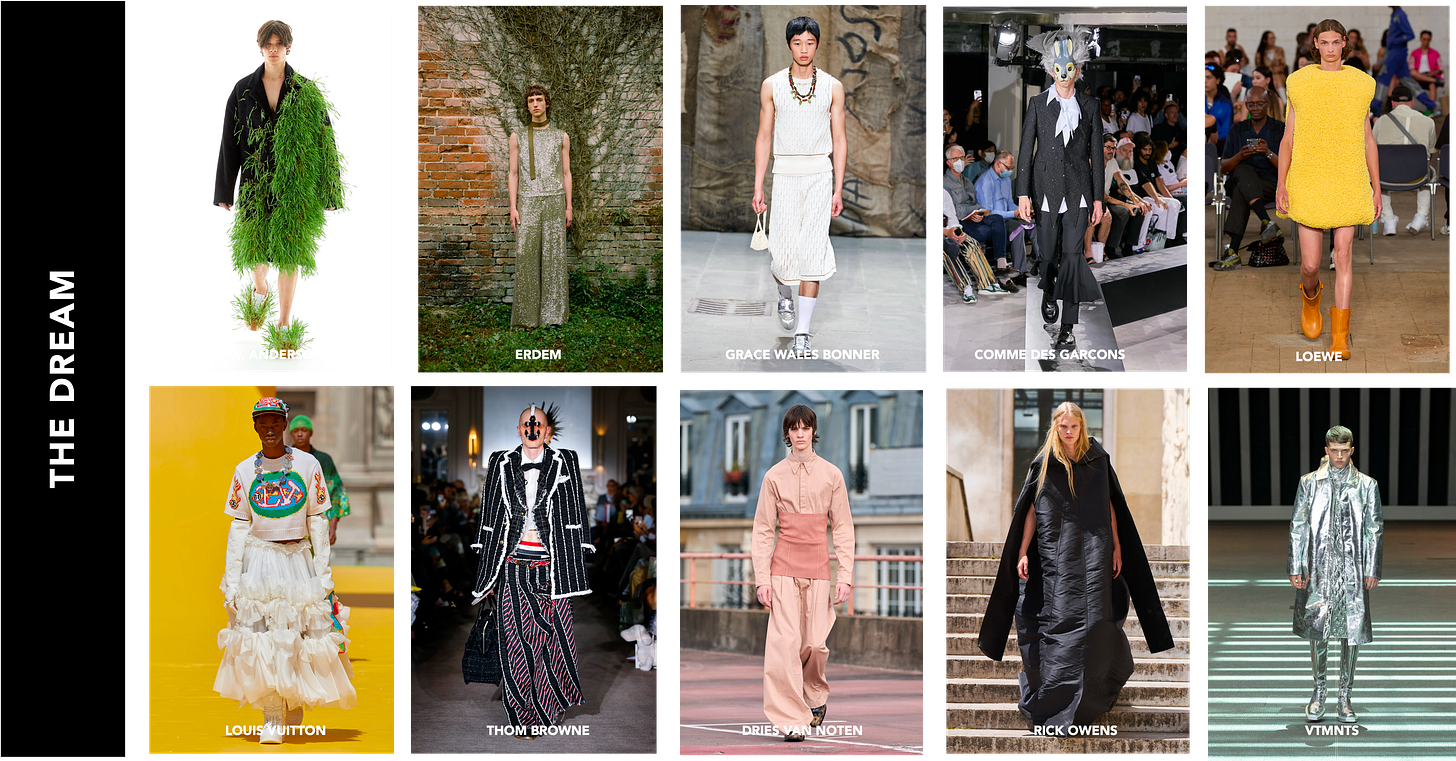Welcome to the Sociology of Business. The Sociology of Business offers a paid membership program. Paid options are for the members of this community who want to be the first to access everything from Web3 brand-building to the new business models and emerging creative formats. Since its inception, the Sociology of Business has been the source code for many other analyses, strategies and brand-building approaches. Members will now have the front-row seat. If you are not yet subscribed, join the community by subscribing below and joining the Sociology of Business Discord. You can find my book, The Business of Aspiration on Amazon and you can find me on Instagram and Twitter. For those new here, in my last analysis, Micro Consumer, I explored how brands can achieve scale amid fragmented consumer landscape.
If the recent menswear S23 fashion week is any indication, looks clustered in three categories. These three categories have different value propositions, communication styles and prices.
The three categories are the Dream, the Trend, and the Lifestyle.
The Dream. In this category are looks that demonstrate a creative vision combined with skill and craftsmanship. These are collections that introduce a fresh notion of masculinity, test the balance between sophistication and kitsch, mix practicality and whimsy, and experiment with shapes and materials and push boundaries of newness. The Dream combines strong ideas with convincing execution, and their purpose is to innovate, assert a point of view and mix it with wearability. The Dream is the closest to the conceptual art and performance, made to work in the modern world. Items that belong to the Dream category are the purest expression of what the brand stands for. they are a brand’s North Star. Some brands, like Comme des Garçons, Junya Watanabe and Thom Browne operate exclusively in this category. Others use it to frame and elevate its entire offering. The looks in the Dream are timeless and timely: they are relevant today as much as in 10 years.
The Trend. In the Trend category are brands, looks and products that stylistically predict the zeitgeist. These are the looks we didn’t know we wanted until we saw them, and they shine brightly and live briefly. There is humor, emotion and experimentation in this category as well, but the MO of the Trend collections is to reflect the near future. Color palettes, shapes, prints and materials all set the tone of what’s immediately to come, and with the next fashion cycle, they by default look dated.
The Lifestyle. In the Lifestyle category are items that are timelessly pragmatic. When inspired, looks display cues of the present trend (like ripped jeans at D&G), but their biggest advantage is that they can be worn across fashion moments and decades. Etro, J.W. Anderson and AMI in particular offered in S23 looks built to work in the real world, with the right mix of traditional and aspirational. Prada and Hermes’ are the veterans of the Lifestyle category, powered by excellence in materials and tailoring skill. Dior and Givenchy this season honed on wearability, with items that are comfortable, practical and look good.
Menswear brands can be analyzed based on their distribution on the continuum defined by the Dream, the Trend, and the Lifestyle. The purpose of this analysis is to strategically assess their market power, competitive advantages and customer appeal.
Brands like Comme des Garçons and Thom Browne focus on the Dream category. Ami established itself in the Lifestyle category. The most consistent S23 presentations - Dries Van Noten, J.W. Anderson, Grace Wales Bonner, and Rick Owens - operate in all three categories. Givenchy, Dior, Versace, Dolce & Gabbana and Fendi did not offer anything in the Dream category - their presentations predicted the zeitgeist and made it wearable. This strategy emphasizes fashion/mass market approach versus exclusivity, heritage and luxury. While lucrative short-term, dangers of this approach are that it weakens a brand’s competitive stronghold, price and equity.
Brands that play in all three categories, setting a vision and stretching the concept to the real world:
The rest of this analysis is for paid subscribers. Subscribe to read.
Keep reading with a 7-day free trial
Subscribe to The Sociology of Business to keep reading this post and get 7 days of free access to the full post archives.









